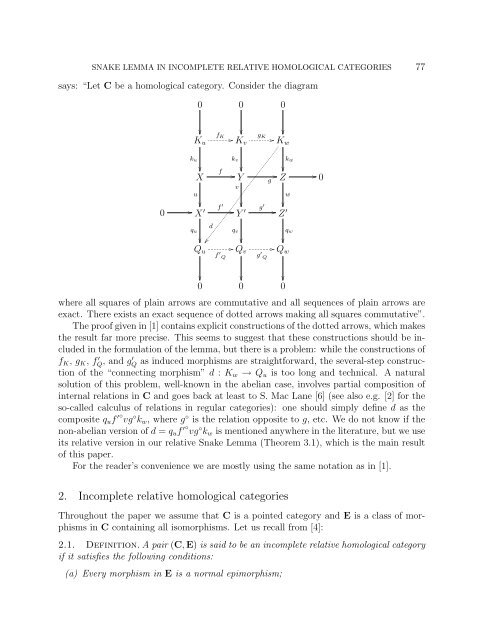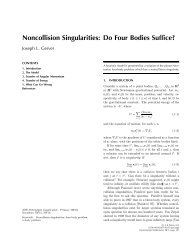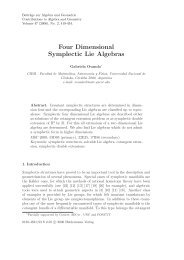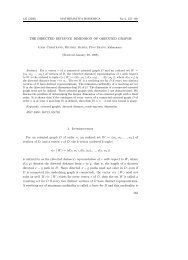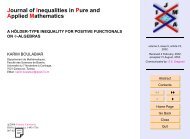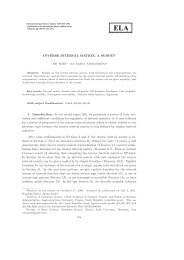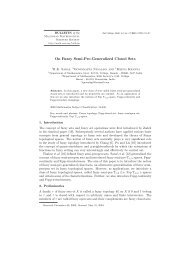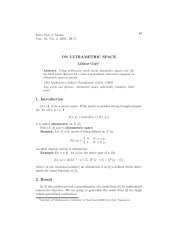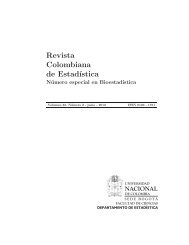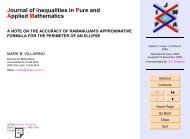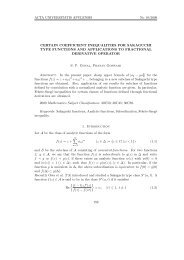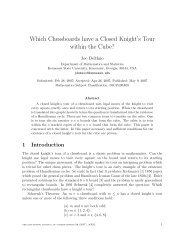SNAKE LEMMA IN INCOMPLETE RELATIVE HOMOLOGICAL ...
SNAKE LEMMA IN INCOMPLETE RELATIVE HOMOLOGICAL ...
SNAKE LEMMA IN INCOMPLETE RELATIVE HOMOLOGICAL ...
Create successful ePaper yourself
Turn your PDF publications into a flip-book with our unique Google optimized e-Paper software.
<strong>SNAKE</strong> <strong>LEMMA</strong> <strong>IN</strong> <strong>IN</strong>COMPLETE <strong>RELATIVE</strong> <strong>HOMOLOGICAL</strong> CATEGORIES 77<br />
says: “Let C be a homological category. Consider the diagram<br />
0<br />
0<br />
0<br />
f K g<br />
K u<br />
<br />
K<br />
K v<br />
<br />
K w<br />
k w<br />
k u k v<br />
<br />
<br />
X f Y g<br />
v<br />
u<br />
0 X ′ f ′ Y ′ g ′ <br />
q u<br />
<br />
Q u<br />
d<br />
f ′ Q<br />
q v<br />
<br />
Q v<br />
g ′ Q<br />
Z<br />
w<br />
Z ′ q w<br />
Q w<br />
0<br />
0 0 0<br />
where all squares of plain arrows are commutative and all sequences of plain arrows are<br />
exact. There exists an exact sequence of dotted arrows making all squares commutative”.<br />
The proof given in [1] contains explicit constructions of the dotted arrows, which makes<br />
the result far more precise. This seems to suggest that these constructions should be included<br />
in the formulation of the lemma, but there is a problem: while the constructions of<br />
f K , g K , f Q ′ , and g′ Q as induced morphisms are straightforward, the several-step construction<br />
of the “connecting morphism” d : K w → Q u is too long and technical. A natural<br />
solution of this problem, well-known in the abelian case, involves partial composition of<br />
internal relations in C and goes back at least to S. Mac Lane [6] (see also e.g. [2] for the<br />
so-called calculus of relations in regular categories): one should simply define d as the<br />
composite q u f ′◦ vg ◦ k w , where g ◦ is the relation opposite to g, etc. We do not know if the<br />
non-abelian version of d = q u f ′◦ vg ◦ k w is mentioned anywhere in the literature, but we use<br />
its relative version in our relative Snake Lemma (Theorem 3.1), which is the main result<br />
of this paper.<br />
For the reader’s convenience we are mostly using the same notation as in [1].<br />
2. Incomplete relative homological categories<br />
Throughout the paper we assume that C is a pointed category and E is a class of morphisms<br />
in C containing all isomorphisms. Let us recall from [4]:<br />
2.1. Definition. A pair (C, E) is said to be an incomplete relative homological category<br />
if it satisfies the following conditions:<br />
(a) Every morphism in E is a normal epimorphism;


